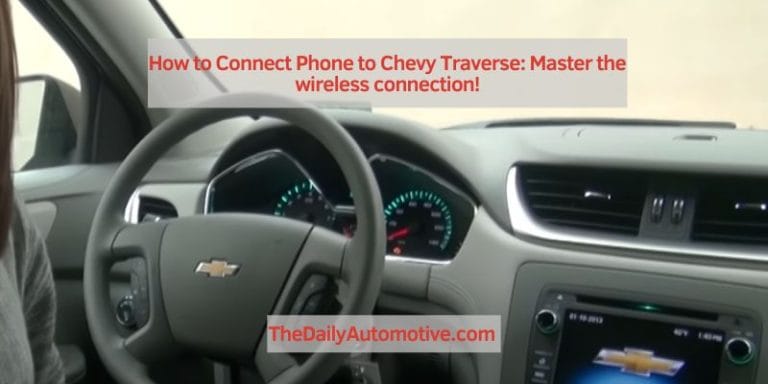How to Decode Engine Light Codes Without a Scanner Chevy: Easy Steps
To check engine light codes without a scanner on a Chevy, start by turning the ignition key on and off three times without starting the engine. Then, count the number of times the check engine light flashes, each flash representing a number in the trouble code.
Once you have the code, refer to a reliable online resource or consult a mechanic to determine the issue and potential solutions. By following these steps, you can diagnose engine problems without the need for a scanner on a Chevy.
Understanding Engine Light Codes
Understanding engine light codes is essential for vehicle owners as it allows them to diagnose potential issues and take appropriate actions. When the engine light illuminates on your Chevy, it indicates that the onboard diagnostic system has detected a problem with the engine or emissions system. By understanding engine light codes, you can make an informed decision about whether to continue driving or seek immediate repairs. In this section, we will explore the common reasons for engine light activation and the different types of engine light codes you may encounter.
Common Reasons For Engine Light Activation
There are several common reasons why the engine light may activate in your Chevy. These reasons could range from relatively minor issues to more serious problems that require immediate attention. Here are a few common causes:
- Loose gas cap: A loose or damaged gas cap can result in a fuel system leak, triggering the engine light.
- Oxygen sensor malfunction: The oxygen sensor measures oxygen levels in the exhaust, and a faulty sensor can cause the engine light to turn on.
- Mass airflow sensor problems: Issues with the mass airflow sensor, such as a dirty or damaged sensor, can affect the engine’s air-fuel mixture and trigger the engine light.
- Catalytic converter failure: A malfunctioning catalytic converter can disrupt emission control systems and lead to the engine light coming on.
- Spark plug or ignition coil issues: Worn-out spark plugs or faulty ignition coils can cause misfires and trigger the engine light.
Types Of Engine Light Codes
When checking engine light codes without a scanner on your Chevy, you will need to rely on the vehicle’s built-in diagnostic system. This system communicates potential problems through a series of codes, known as Diagnostic Trouble Codes (DTCs). It’s important to remember that DTCs are not precise diagnoses, but rather indications of a particular issue or system error. Below are the two main types of engine light codes:
| Generic Codes (P0xxx) | Manufacturer-Specific Codes (P1xxx) |
|---|---|
| Generic codes are standardized across all vehicle manufacturers and provide a general overview of the problem area. While they can indicate the affected system, further diagnostic steps are often required to identify the precise cause. | Manufacturer-specific codes, as the name suggests, are specific to the particular vehicle make and model. These codes provide more detailed information about the issue and can aid in accurate diagnosis and repair. |
Understanding the difference between these types of codes can help you interpret the engine light signals more effectively when troubleshooting your Chevy.
Decoding Engine Light Codes Without A Scanner – Easy Steps
When your Chevy’s check engine light comes on, it can be a cause for concern. You might be wondering what the problem could be and if it requires a costly trip to the mechanic. But fear not, because in this article, we will guide you through the easy steps of decoding engine light codes without a scanner for your Chevy. By following these simple steps, you can gain valuable insight into the issue and potentially save money on unnecessary repairs. So, let’s get started!
Step 1: Turn On The Ignition Without Starting The Engine
In this first step, you need to ensure that the engine is not running but the ignition is turned on. Simply insert the key, and turn it to the “on” position without starting the engine. This will power up the vehicle’s electrical systems, including the check engine light.
Step 2: Count The Engine Light Flashes
Once the ignition is on, the check engine light on your Chevy will start to flash. You’ll notice a series of short and long flashes. It’s essential to pay attention to the pattern of these flashes, as they indicate specific trouble codes.
To count the flashes accurately, observe the duration of each flash and the pause between them. For example, a short flash could represent a unit digit, while a long flash could symbolize a tens digit. Take note of the number of short and long flashes, as this will aid in determining the trouble code.
Step 3: Interpret The Code Using An Engine Light Code Reference
Now that you have counted the flashes, it’s time to interpret the code. This step involves using an engine light code reference specific to your Chevy model. These references are available online, in repair manuals, or through dedicated mobile applications. Simply locate your trouble code in the reference, and it will provide you with information about the specific issue triggering the check engine light.
Remember to refer to an accurate and up-to-date reference, as codes can vary depending on your vehicle’s make, model, and year. Additionally, the reference may also provide advice on possible solutions or recommended actions to resolve the problem.
By following these three easy steps – turning on the ignition without starting the engine, counting the engine light flashes, and interpreting the code using an engine light code reference – you can gain valuable insights into the issues triggering your Chevy’s check engine light. Armed with this information, you can make informed decisions on how to address the problem, whether by tackling it yourself or seeking professional assistance.
Conclusion
To conclude, learning how to check engine light codes without a scanner for your Chevy car is a valuable skill that can save you time and money. By following the steps outlined in this guide, you can diagnose and troubleshoot issues with your vehicle on your own.
Remember to always consult your vehicle’s manual and seek professional help if needed. With a bit of patience and practice, you can become more confident in understanding and resolving engine light issues without relying on a scanner. Happy troubleshooting!







